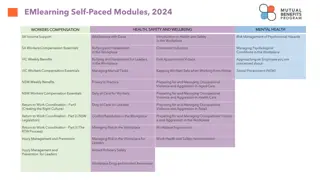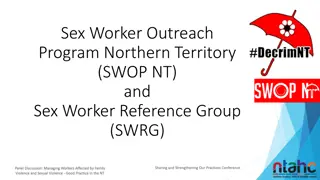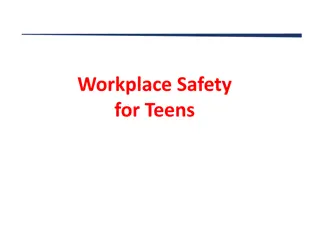Understanding Workplace Safety and Risk Management for Young Workers
This introduction covers the importance of work health and safety, risk management basics, and young workers' responsibilities and rights. It delves into real-life injury stories, work health and safety laws, and emphasizes the need for a safe work environment. Through a four-step process of risk management, young workers are empowered to stay safe and make informed decisions at work.
Download Presentation

Please find below an Image/Link to download the presentation.
The content on the website is provided AS IS for your information and personal use only. It may not be sold, licensed, or shared on other websites without obtaining consent from the author. Download presentation by click this link. If you encounter any issues during the download, it is possible that the publisher has removed the file from their server.
E N D
Presentation Transcript
An introduction to risks at work For young workers
Overview At the end of this session, you should be able to answer the following questions: Why is work health and safety important? What is risk management? What are the three things that support you to stay safe at work?
Section one: Why is work safety important?
Valuing your health and safety Have you experienced someone having been injured at work? Or a near-miss? Have you felt that your safety was at risk when performing any tasks? How would a workplace injury affect your life?
What is the issue? 4400 people aged between 15 and 24 years are seriously injured at work every year in Queensland.
Every injury has its own story Watch Jason s film
Every injury has its own story Watch Dale Kennedy s film
Work health and safety laws Your responsibilities Your rights Your employer s responsibilities Provide a safe work environment. Provide information, training, instruction and supervision. Talk with you about health and safety. Appoint a safety committee or safety representatives if requested. Take reasonable care of your health and safety. Don t endanger other people through your actions. Follow reasonable instructions and policies. Stop or refuse unsafe work. No negative repercussions for raising health and safety concerns. Elect a health and safety representative (HSR).
Section two: Risk management the basics
Risk management The four-step process for managing workplace risks: Consulting and communicating is an important part of the whole process.
Step 1 - Identify A hazard is something that has the potential to cause harm. Identifying hazards is simply finding out what could cause harm. How? Think about the types of hazards that might exist in your workplace. Ask questions such as: o What is going on around me? o What could hurt me? o Who can I ask?
Step 1 - Identify Activity fill in the blanks: Types of hazard Potential harm Manual tasks Muscle strains and sprains Gravity Falls from height, slips and trips Electric shock, burns, electrocution Machinery and equipment Hazardous chemicals Respiratory conditions, cancers, skin conditions Extreme temperatures Heat stress Hearing loss Radiation Burns, eye damage etc. Biological Diseases or infection Psychological
Step 1 - Identify Which of these hazards are present in this workplace? Types of hazard Potential harm Manual tasks (e.g. lifting, carrying) Muscle strains and sprains Gravity Falls from height, slips and trips Electrical Electric shock, burns, electrocution Machinery and equipment Being hit by vehicles, amputations from unguarded machines Chemicals Respiratory conditions, cancers, skin conditions Extreme temperatures Heat stress Noise Hearing loss Radiation (e.g. welding, lasers) Burns, eye damage etc. Biological (e.g. veterinary, healthcare) Diseases or infection Psychological Effects from stress, bullying, violence or fatigue
Step 2 - Assess A risk assessment involves considering the following things: 1. What could go wrong? 2. How likely is it to occur? 3. What are the consequences? 4. How could it be prevented? 5. How urgently should I act?
Step 3 Control A control measure is something to help prevent you or someone else from getting hurt. Level one Eliminate: Eliminate the hazard altogether Most protection Level two Isolate/substitute: Use safer equipment and materials Keep people away from danger, using exclusion zones and machine guarding Level three Procedures: Follow safe work procedures Wear personal protective equipment (PPE) Least protection
Step 4 Check Control measures should be checked regularly to review: that they work they are easy to follow people know what to do if anything else can be done.
Section three: What does a safe workplace look like?
A safe workplace A safe workplace should include three things: Supervision and feedback Induction and training Support and mentoring
The right start building safe work for young workers Watch The right start film
Question time What were the three things used in the good example to keep the young worker safe?
Question time What were the three things used in the good example to keep the young worker safe? Supervision and feedback Induction and training Support and mentoring
Ask yourself Do I follow the four steps? 1. Identify 2. Assess 3. Control 4. Check Managing risks Can I participate in ongoing inductions and safety training? Induction and training Does my supervisor give me feedback about my work? Do you notify your supervisor of any safety concerns? Do you report injuries or near-misses? Supervision Can I access support and mentoring? Support Who can help me with safety? Do you get involved in health and safety? Getting involved
Taking action List your top three ideas for making your job safer. Think about how to make that happen. Find out who can help you make these changes.























